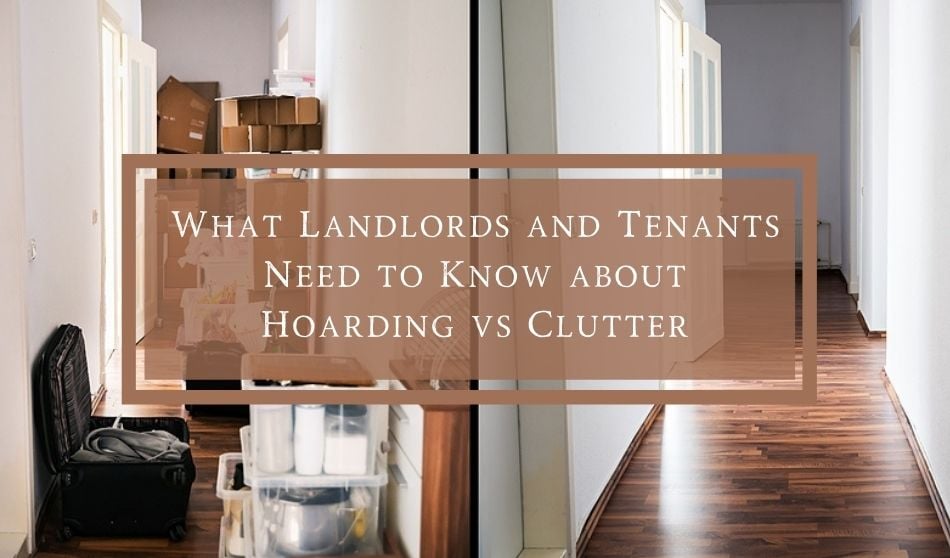
Let’s talk about clutter and hoarding. Although there are inherent hazards and concerns, the topic is often glossed over or not addressed.
There are similarities between the sentimental collector, the packrat or clutter bug, and the messy and disorganized. However, hoarding can include any and all of these categories to an extreme.
From personal experience, getting the facts about hoarding then working with renters, understanding and the right attitude goes a long way. Read on for some insight and helpful tips when either helping a tenant or getting help if you struggle with clutter or hoarding.
Clutter vs. Hoarding
Managing a mobile home park with renters and owner-occupied homes, I noticed on one of my first walkabouts a home with dozens of outdoor plants in disarray and various stages of care. Among those were an extreme amount of empty pots, lawn decor, and gardening tools and supplies. Someone would be hard-pressed to make their way through the maze.
Not many days later I noticed a vehicle parked in front of the home nearly full of belongings and debris. The final clue was a walkabout to check that all holiday decor had been taken down and that window blinds and curtains met with community guidelines. Not only was that renter out of compliance on both, one curtain had slipped and I could see boxes and items stacked to the ceiling.
Now, these three observations didn’t necessarily mean the renter was struggling with hoarding, but they were good indications it was at least headed in that direction.
It’s important when you first suspect hoarding not to jump to conclusions or make quick judgments; and we’ll go into why that’s important in a minute. For now, knowing some signs of hoarding like the examples above can help you decide on an action plan.
Signs of Hoarding
Many of these signs by themselves could be a cause for concern. However, when combined and in extreme conditions, you likely have someone struggling with hoarding.
- Overwhelming smells
- Over the pet limit, accumulated pet waste, and stains
- Walkways and rooms are challenging to navigate
- Visible mold and mildew
- Evidence of and/or neighbor complaints of pests
- Tenant restricts or denies landlord and vendors access to the home, garage, storage
- Too many items outdoors
- Unreported broken appliances and features
- Vehicle interior full of personal items and debris
- Getting pushback and justifications for cleanup requests
- Not willing to cooperate with cleanup efforts
Signs of a Messy Disorganized Home
If you see the following signs, it could be that the tenant is experiencing difficulties with keeping up on housework or has other things going on in their lives. Stress can often disrupt our normal patterns. Many are struggling to balance working from home, homeschooling their children, and managing best they can through these difficult times so organization and clutter haven’t been a priority.
- Slight smell
- Personal items stacked on tables, counters, and furniture
- More than a few loads worth of unwashed laundry
- More than one day worth of dirty dishes
- Dust, stains, and other cleaning tasks undone
- A tenant may be shy and apologetic about the clutter but still allows easy access to the rental
- Willing to cooperate with cleanup efforts without pushback and justification
- Follow through on clean up requests.
What can a landlord do when they suspect hoarding?
One – Start with Empathy
You recognize the signs of hoarding and want to protect your investment; a wise move. But how you address your concern is vitally important. For that, it’s good to know what causes hoarding and what’s behind that behavior.
Someone who is disorganized and messy or a pack rat may be dealing with being overwhelmed or stressed. They can reason and make decisions on limits and cleanup. But a hoarder would find it difficult without help and support to make those changes, set limits, or manage the cleanup alone. They are, in fact, dealing with a mental health issue as classified in the American Psychiatric Association DMS-5 manual.
Regardless of the amount of clutter from messy to hoarding, compassion and patience are key in getting cooperation and being an advocate and support for those struggling.
Two – Remember the Fair Housing Act
Because hoarding is a mental disorder; it’s vitally important to approach the situation carefully. Hoarding is protected as a disability under the Fair Housing Act. As such, the Department of Housing and Urban Development (HUD) suggests taking a collaborative intervention approach to tenant hoarding.
Three – Establish a Thorough Lease Cleanliness Clause
Update your lease to include a cleanliness clause if it’s lacking. Be sure to check your state guidelines and have an attorney review any lease changes and addendums before use.
Set expectations in your lease when creating your cleanliness clause. Be detailed about garbage collection and removal, pet concerns, mold and mildew prevention, fire hazards, routine cleaning tasks, etc.
Having this well defined will help you send out appropriate violation notices after inspections. A vague lease could make it more difficult if a situation becomes a court battle.
Four – Document Efforts
In the same vein, there may be a need to follow through with an eviction, and having all things well documented can be very helpful. Types of things to document:
- Lease violations notices
- Inspection reports and pictures
- All communications to and from the tenant
- History of helpful attempts
- Direct or indirect (newsletters) offers of community assistance: yard cleanup, junk removal, free dumpsters, community yard sales
Five – Reach Out to Outside Support
Although eviction might be an option, after you’ve exhausted your efforts without evidence of change, there are a few other options to try. Although a tenant might not appreciate the tough-love approach it may become necessary to make the hard decision to call the health department, fire department, adult protective services, or other agencies to get outside support for your efforts to help the hoarding tenant.
Note to Tenants:
Just as the landlord needs to protect their investment, they also care about their tenants. If you are a renter and your landlord has suggested you make efforts to declutter and clean, remember that it is for your best interest. They are looking out for your health and safety as well as keeping you safe from fire hazards, pest infestations, and mold and mildew issues.
Difficult as it is, no matter where on the tidy spectrum you land, now is a good time to take a look at your environment and decide if it is serving your best interests and life purpose. It’s not always easy to find a starting point so it may help if you focus first on those items of disarray related to health, safety, fire, and pests such as:
- Unblock doorways and clear walking paths
- Gather and remove garbage
- Do a deep clean in areas prone to mold and mildew
- Spring clean kitchen and remove piles that may attract pests
Getting help could be as simple as watching inspiring videos or reading articles to improve your home like these:
Fall Decluttering for Renters
Messies Anonymous | The Organizer Lady
Tenant Tips for Pest Infestations in a Rental
Best Way to Organize Your Apartment
Home and Office Cleaning Tips for a Safe Environment
How to Get Rid of Bad Smells in Your Apartment
But…
If it goes beyond being disorganized and messy, don’t wait to seek help. You are not alone, many before you have struggled with hoarding but found compassionate help — you are worthy of that same type of support and care.
Hoarding Resources
International OCD Foundation | Hoarding Resource Directory and Information
https://hoarding.iocdf.org
American Psychiatric Association | Help With Hoarding Disorder
https://www.psychiatry.org/patients-families/hoarding-disorder
Nationwide Hoarding Cleanup Directory, Resources, and Support
https://hoardingcleanup.com/national_resources
The End of the Story
It didn’t happen overnight but the story above ended well for all parties involved. It took empathy (offering help and services) coupled with a focus on their mental health needs (time and patience) and balanced with good property management protocols (notifications and documentation).
Hoarding can create a health and safety hazard that needs to be addressed to protect your investment. But because hoarders are in a constant battle within themselves, they need a compassionate approach to find healing.
RELATED READING FOR YOU:
- The Fair Housing Act: Anti-Discrimination Laws for Landlords and Property Managers
- The Best Communication Tips for Landlords and Renters
- Important Inspections for Your Rental Property






Heather, yet again I find myself impressed with your writing and it’s content. Relevant, SO helpful, and you never forget to address what is most important: the humanity within us all. I appreciate you (and those who employ such skilled folks:) and this article immensely. Thank you.
My pleasure! Thanks again and I appreciate you for your kindness in taking the time to send such great encouragement.
I find your article to be missing the facts about hoarders putting other tenants at risk for fire and safety, not to mention the pests and nasty animal feces and smells that find there way into other units. I was hoping your article would be more clear on what tenants and landlords can do to ensure the safety of all tenants in a shared community. Hoarders don’t want help and your soft approach doesn’t save innocent lives from being protected against FIRE AND MANY OTHER SAFETY CONCERNS. Maybe you can do another article that’s more informative on how to take action against the nasty lifestyle that affects the innocent neighbors that are at serious risk for bodily harm!!! Thank you for your time!
I completely agree that hoarding can pose serious health and safety issues. My heart goes out to anyone whose lives have been impacted by the consequences of hoarding behavior. My intention for the article was to help landlords recognize the signs of hoarding — and then offer the gentle approach recommended by mental health professionals and HUD (Department of Urban Housing and Development), as well as share my personal experience.
Although the gentle approach is a good place to start, you might have missed in the article that there is a a time and place where evictions and/or calling in the authorities is necessary. I hope that advocating for compassion and empathy doesn’t translate to a message of apathy as I don’t believe the situation should be ignored — everyone is entitled to a safe and healthy environment and landlords should proceed in the best manner for all parties involved.
Oh so glad you had a spot to ask a question. My mom’s house is the first house to be build by all women in USA. I had hoarders move in, I at one point calculated they have maybe 8 tons or more on a 1977 house wood frame, besides the fire hazards and the collapse of the house, as they implode, I do not want to ask for them to clean, its just too much and it will continue as they literally have UPS up every day of the week except Sunday loading more stuff, then all the hoarders electric toys pulling electricity thru old wiring system. They think I am paranoid. But the mess is on the deck, and behind the house deck tons of trash and bags, and they assured me all on the deck was fire proof, as I live in Santa Cruz Mountains and I just narrowly missed my house being burned to the ground with the fires of 2020. Meanwhile I asked to neighbors so, you think all this stuff on the deck is fireproof as they claimed, they both had a good laugh, that how duh and how could they even imagine lying about such a obvious, defy your eyes trashville look. What do you think about me asking my local fire chief to assess the situation? When I entered the house once, it was so packed with heavy furniture, boxes up to the top high rise ceiling and they said they were not hoarders but when I called the landlord they confirmed, they were. So can you evict for ommission and lying. Thank you for your time, I just seek to save my mamacitas legacy from total ruin.
Hi Ella!
Thanks for sharing with us your mother’s special place in history. I am uncertain if the local fire chief will investigate from a third-party request — the landlord or direct neighbor might need to make that call. Landlord laws on evictions are a complicated legal matter, especially in California. Unfortunately, I can not give legal advice but can say the landlord will need to review the lease agreement and local and state laws (and likely a real estate attorney) to decide how to proceed. You might want to offer the landlord this article to give them some helpful tips.
I do understand your concern over your mother’s legacy, for sure. But I’d like to offer a final note that it might be a good idea to limit your interaction with the neighbors, occupant, and property in general so that your concern isn’t misunderstood as harassment or trespassing. Hoping the landlord will take the lead and find the tenant and home the help they need.
Hi Heather. Frist i want you to know I enjoyed your article, it was informative. I live with my daughters and 2 grand kids. She is showing signs of hoarding and if I say anything to her I get snapped at or lied to . the city was out here taking pic. of our yard. Now i’m afraid of us being evicted. How do i bring this up to someone who won’t listen?
That must be a very difficult situation Raymond. Unfortunately, I’m not certain I’d be any help with advice accept to suggest you reach out to trained professional in your area familiar with helping families with hoarding. Here are three from the article that might prove helpful:
International OCD Foundation | Hoarding Resource Directory and Information
https://hoarding.iocdf.org
American Psychiatric Association | Help With Hoarding Disorder
https://www.psychiatry.org/patients-families/hoarding-disorder
Nationwide Hoarding Cleanup Directory, Resources, and Support
https://hoardingcleanup.com/national_resources